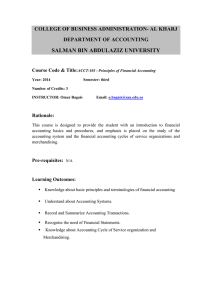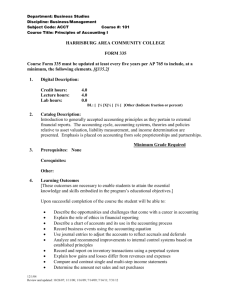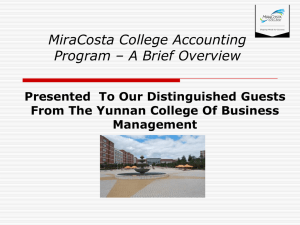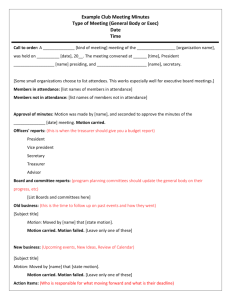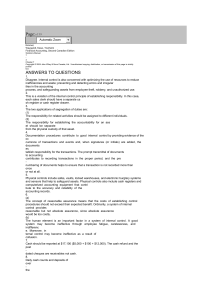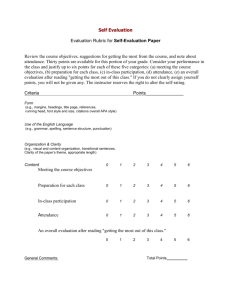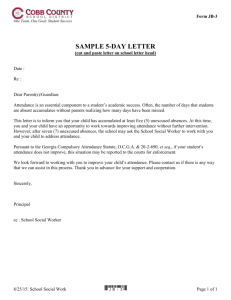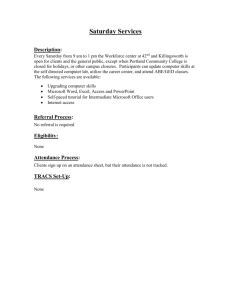Master Course Syllabus - Tompkins Cortland Community College
advertisement
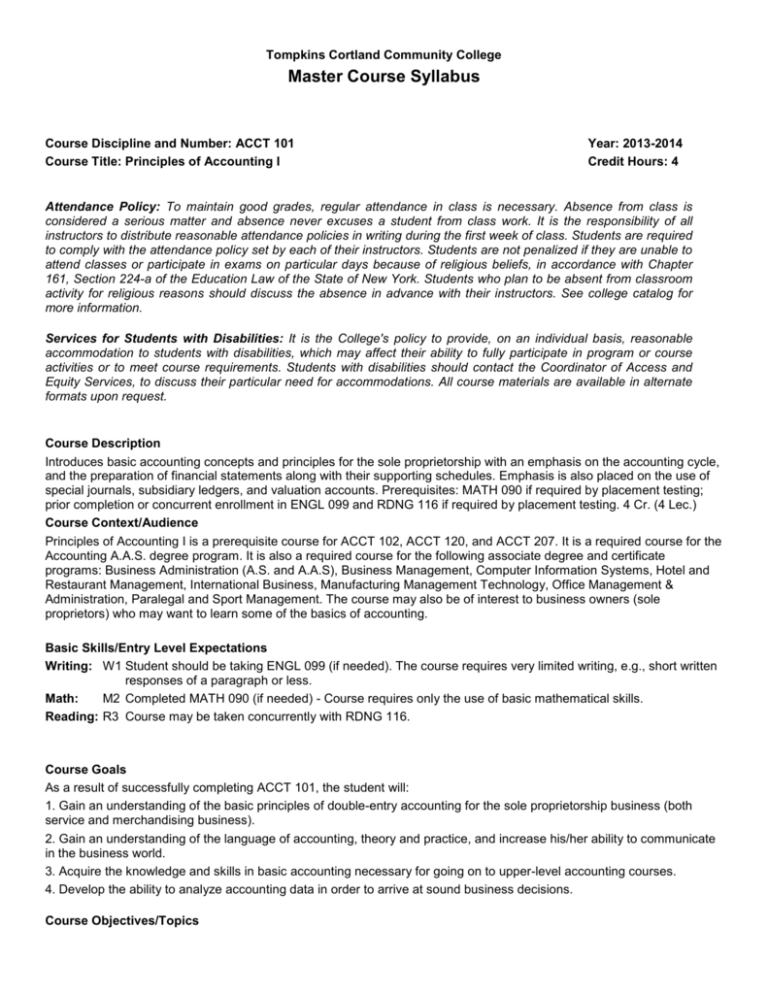
Tompkins Cortland Community College Master Course Syllabus Course Discipline and Number: ACCT 101 Course Title: Principles of Accounting I Year: 2013-2014 Credit Hours: 4 Attendance Policy: To maintain good grades, regular attendance in class is necessary. Absence from class is considered a serious matter and absence never excuses a student from class work. It is the responsibility of all instructors to distribute reasonable attendance policies in writing during the first week of class. Students are required to comply with the attendance policy set by each of their instructors. Students are not penalized if they are unable to attend classes or participate in exams on particular days because of religious beliefs, in accordance with Chapter 161, Section 224-a of the Education Law of the State of New York. Students who plan to be absent from classroom activity for religious reasons should discuss the absence in advance with their instructors. See college catalog for more information. Services for Students with Disabilities: It is the College's policy to provide, on an individual basis, reasonable accommodation to students with disabilities, which may affect their ability to fully participate in program or course activities or to meet course requirements. Students with disabilities should contact the Coordinator of Access and Equity Services, to discuss their particular need for accommodations. All course materials are available in alternate formats upon request. Course Description Introduces basic accounting concepts and principles for the sole proprietorship with an emphasis on the accounting cycle, and the preparation of financial statements along with their supporting schedules. Emphasis is also placed on the use of special journals, subsidiary ledgers, and valuation accounts. Prerequisites: MATH 090 if required by placement testing; prior completion or concurrent enrollment in ENGL 099 and RDNG 116 if required by placement testing. 4 Cr. (4 Lec.) Course Context/Audience Principles of Accounting I is a prerequisite course for ACCT 102, ACCT 120, and ACCT 207. It is a required course for the Accounting A.A.S. degree program. It is also a required course for the following associate degree and certificate programs: Business Administration (A.S. and A.A.S), Business Management, Computer Information Systems, Hotel and Restaurant Management, International Business, Manufacturing Management Technology, Office Management & Administration, Paralegal and Sport Management. The course may also be of interest to business owners (sole proprietors) who may want to learn some of the basics of accounting. Basic Skills/Entry Level Expectations Writing: W1 Student should be taking ENGL 099 (if needed). The course requires very limited writing, e.g., short written responses of a paragraph or less. Math: M2 Completed MATH 090 (if needed) - Course requires only the use of basic mathematical skills. Reading: R3 Course may be taken concurrently with RDNG 116. Course Goals As a result of successfully completing ACCT 101, the student will: 1. Gain an understanding of the basic principles of double-entry accounting for the sole proprietorship business (both service and merchandising business). 2. Gain an understanding of the language of accounting, theory and practice, and increase his/her ability to communicate in the business world. 3. Acquire the knowledge and skills in basic accounting necessary for going on to upper-level accounting courses. 4. Develop the ability to analyze accounting data in order to arrive at sound business decisions. Course Objectives/Topics Objective/Topic # Hours The student will be able to explain why ethics and social responsibility are crucial to accounting. 1 Hour The student will be able to explain and interpret the accounting equation. 1 Hour The student will be able to identify and prepare basic financial statements. 1 Hour The student will understand and apply the various accounting principles. 1 Hour The student will be able to analyze and record business transactions using the accounting equation. 1 Hour The student will be able to prepare financial statements from business transactions. 1 Hour The student will understand what an account is and how it is used in recording information. 1 Hour The student will understand debits and credits and be able to use them properly in transactions. 2 Hours The student will be able to post from a journal to a ledger, and then prepare an accurate trial balance. 2 Hours The student will be able to prepare adjusting entries at the end of the accounting cycle. 1 Hour The student will understand the difference between accruals and deferrals. 1 Hour The student will be able to prepare an adjusted trial balance. 1 Hour The student will understand and be able to prepare closing entries. 2 Hours The student will be able to prepare a post-closing trial balance. 1 Hour The student will be able to prepare a work sheet and explain its use. 2 Hours The student will be able to record transactions for a merchandising business using both the perpetual and periodic inventory system. 4 Hours The student will be able to prepare adjusting entries for a merchandising business. 2 Hours The student will be able to prepare classified balance sheets and income statements. 2 Hours The student will be able to compute ending inventory using FIFO, LIFO, Weighted Average, Retail and Gross Profit methods, and explain when each is used. 4 Hours The student will be able to use the four special journals and explain the purpose for each. 2 Hours The student will be able to post from the special journals to the general ledger and the subsidiary ledgers. 2 Hours The student will understand the need for internal control and the various methods used to obtain this. 1 Hour The student will be able to use the voucher journal and check register. 1 Hour The student will be able to explain and record petty cash transactions from establishment to reimbursement. 1 Hour The student will be able to prepare a bank reconciliation. 1 Hour The student will understand the direct write-off and allowance methods for dealing with accounts receivables. 1 Hour The student will be able to record the various adjusting entries in dealing with accounts receivable. 2 Hours The student will be able to record short-term investment transactions. 1 Hour The student will be able to compute and record depreciation using straight-line, units-of-production, and declining-balance methods. 3 Hours The student will be able to record the disposal of fixed assets by discarding, selling, or trading the assets. 2 Hours The student will understand and explain natural resource and intangible assets. 1 Hour The student will be able to record short-term notes payable. 1 Hour The student will be able to prepare and compute payroll entries for employees. 3 Hours The student will be able to calculate the employer's tax liabilities for payroll. 2 Hours The student will be able to calculate estimated liabilities for warranties and income taxes. 1 Hour Four major exams 4 Hours General Education Goals - Critical Thinking & Social/Global Awareness CRITICAL THINKING OUTCOMES HOW DOES THE COURSE ADDRESS THE OUTCOMES (Include required or recommended instructional resources, strategies, learning activities, assignments, etc., that must or could be used to address the goal/outcomes) Students will be able to develop meaningful questions to address problems or issues. gather, interpret, and evaluate relevant sources of information. reach informed conclusions and solutions. consider analytically the viewpoints of self and others. SOCIAL/GLOBAL AWARENESS OUTCOMES Students will begin to understand how their lives are shaped by the complex world in which they live. Students will understand that their actions have social, economic and environmental consequences. HOW DOES THE COURSE ADDRESS THE OUTCOMES (Include required or recommended instructional resources, strategies, learning activities, assignments, etc., that must or could be used to address the goal/outcomes) Instructional Methods The primary method for teaching this course should be the lecture. Lectures should cover text material and should include presentations about practical, every-day accounting experiences. Along with the lecture, many exercises and problems should be assigned and then discussed in class. Methods of Assessment/Evaluation Method % Course Grade Four major exams over the course of the semester covering the 12 textbook chapters 80% Homework and class attendance/participation 20% Text(s) Accounting Principles, Weygandt, Kieso, Kimmel, 7th Edition, © 2005 Wiley. Required Working Papers for Use With Accounting Principles, Chapters 1-12, Weygandt, Kieso, Kimmel, 7th Edition, © 2005 Wiley. Required Bibliography The Financial Accounting Standards Board is the governing body which updates the GAAP. It is always a good idea to annually check out any actions they may have taken. The Instructor’s Guide for Accounting Principles, Weygandt, Kieso, Kimmel, 7th Edition, © 2005, Wiley is very helpful in the preparation for teaching this course. Other Learning Resources Audiovisual No resources specified Electronic AccountantsWorld.com is a good resource to use for keeping up to date with changes that are happening in the accounting profession. ExamView.com website is an excellent source to use for setting up review tests and homework for students who have online access. Other For online sections, a password is needed to access the Wiley textbook website where the homework and tests are accessed. This is part of the textbook package.
